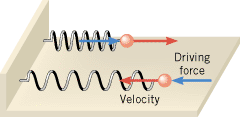10.6.
Driven Harmonic Motion and Resonance
In damped harmonic motion, a mechanism such as friction dissipates or reduces the energy of an oscillating system, with the result that the amplitude of the motion decreases in time. This section discusses the opposite effect—namely, the increase in amplitude that results when energy is continually added to an oscillating system.
To set an object on an ideal spring into simple harmonic motion, some agent must apply a force that stretches or compresses the spring initially. Suppose that this force is applied at all times, not just for a brief initial moment. The force could be provided, for example, by a person who simply pushes and pulls the object back and forth. The resulting motion is known as driven harmonic motion, because the additional force drives or controls the behavior of the object to a large extent. The additional force is identified as the driving force.
Figure 10.26 illustrates one particularly important example of driven harmonic motion. Here, the driving force has the same frequency as the spring system and always points in the direction of the object’s velocity. The frequency of the spring system is  and is called a natural frequency, because it is the frequency at which the spring system naturally oscillates. Since the driving force and the velocity always have the same direction, positive work is done on the object at all times, and the total mechanical energy of the system increases. As a result, the amplitude of the vibration becomes larger and will increase without limit, if there is no damping force to dissipate the energy being added by the driving force. The situation depicted in Figure 10.26 is known as resonance.
and is called a natural frequency, because it is the frequency at which the spring system naturally oscillates. Since the driving force and the velocity always have the same direction, positive work is done on the object at all times, and the total mechanical energy of the system increases. As a result, the amplitude of the vibration becomes larger and will increase without limit, if there is no damping force to dissipate the energy being added by the driving force. The situation depicted in Figure 10.26 is known as resonance.
 | | Figure 10.26
Resonance occurs when the frequency of the driving force (blue arrows) matches a frequency at which the object naturally vibrates. The red arrows represent the velocity of the object. |
|
| RESONANCE |
|
Resonance is the condition in which a time-dependent force can transmit large amounts of energy to an oscillating object, leading to a large amplitude motion. In the absence of damping, resonance occurs when the frequency of the force matches a natural frequency at which the object will oscillate.
|
The role played by the frequency of a driving force is a critical one. The matching of this frequency with a natural frequency of vibration allows even a relatively weak force to produce a large amplitude vibration, because the effect of each push-pull cycle is cumulative.
Resonance can occur with any object that can oscillate, and springs need not be involved. The greatest tides in the world occur in the Bay of Fundy, which lies between the Canadian provinces of New Brunswick and Nova Scotia. Figure 10.27 shows the enormous difference between the water level at high and low tides, a difference that in some locations averages about 15 m. This phenomenon is partly due to resonance. The time, or period, that it takes for the tide to flow into and ebb out of a bay depends on the size of the bay, the topology of the bottom, and the configuration of the shoreline. The ebb and flow of the water in the Bay of Fundy has a period of 12.5 hours, which is very close to the lunar tidal period of 12.42 hours. The tide then “drives” water into and out of the Bay of Fundy at a frequency (once per 12.42 hours) that nearly matches the natural frequency of the bay (once per 12.5 hours). The result is the extraordinary high tide in the bay. (You can create a similar effect in a bathtub full of water by moving back and forth in synchronism with the waves you’re causing.)
 | | Figure 10.27
The Bay of Fundy at (a) high tide and (b) low tide. In some places the water level changes by almost 15 m. (© Everett Johnson/Leo de Wys, Inc.) |
|
 |
| Copyright © 2000-2003 by John Wiley & Sons, Inc. or related companies. All rights reserved. |
 and is called a natural frequency, because it is the frequency at which the spring system naturally oscillates. Since the driving force and the velocity always have the same direction, positive work is done on the object at all times, and the total mechanical energy of the system increases. As a result, the amplitude of the vibration becomes larger and will increase without limit, if there is no damping force to dissipate the energy being added by the driving force. The situation depicted in Figure 10.26 is known as resonance.
and is called a natural frequency, because it is the frequency at which the spring system naturally oscillates. Since the driving force and the velocity always have the same direction, positive work is done on the object at all times, and the total mechanical energy of the system increases. As a result, the amplitude of the vibration becomes larger and will increase without limit, if there is no damping force to dissipate the energy being added by the driving force. The situation depicted in Figure 10.26 is known as resonance.
